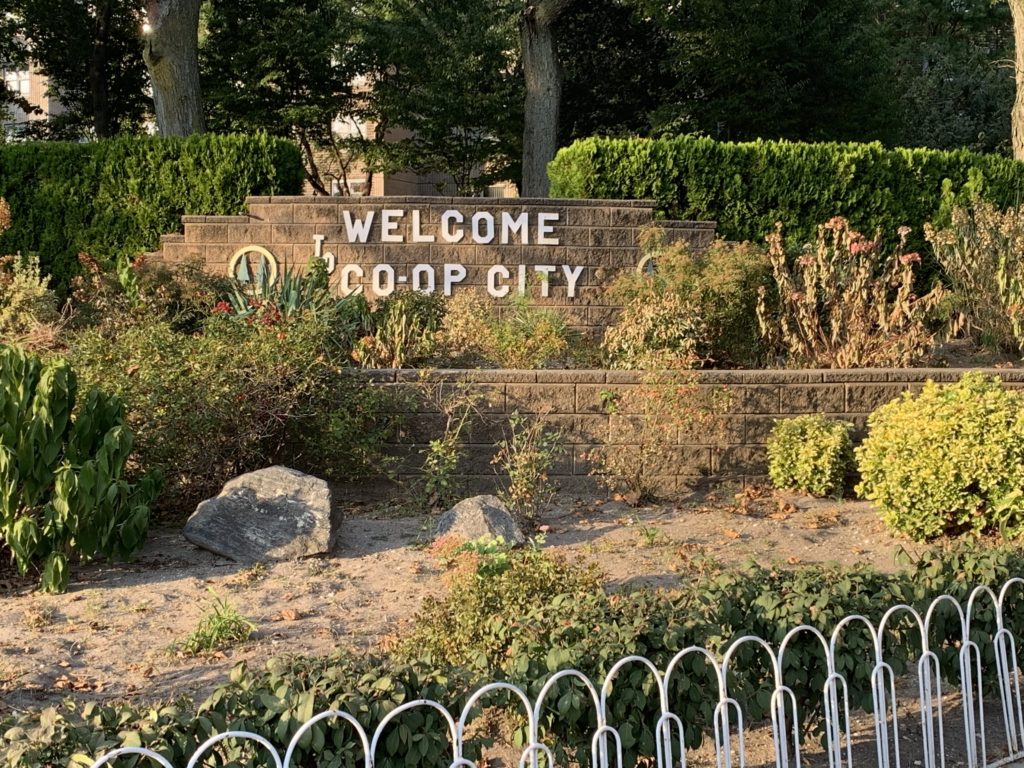
What's Happening In Coop City?

Co-Op Sales: A Legacy of Home Improvement Excellence in New York


Since its inception in 1969 by the visionary Sam Lash, Co-Op Sales has been a cornerstone of home improvement in New York, serving the five boroughs, Westchester, and Long Island with unparalleled dedication. Renowned for exceptional quality workmanship and fostering strong customer relationships, Co-Op Sales has become synonymous with trust and superior service in the home improvement realm.
Under the leadership of Jason Lash, who took the helm in 1998, the company has not only upheld its father’s legacy but has expanded its offerings to meet the evolving needs of modern homeowners. Co-Op Sales’ extensive range of services includes custom-designed kitchens, top-tier window fashions, comprehensive bathroom solutions, and bespoke mirror closet doors, to name but a few.
With a state-of-the-art factory and warehouse based in Long Island, Co-Op Sales is fully equipped to cater to all your custom cabinetry requirements. The team’s commitment to excellence ensures that your home improvement projects are in the most capable hands.
Jason Lash, as CEO, continues to drive Co-Op Sales to new heights, honoring his father’s name and building upon the company’s storied success. Whether it’s custom kitchens, brand-name cabinetry, complete bathroom sets, or a wide array of flooring options, window treatments, and closet doors, Co-Op Sales is your trusted partner in bringing your home improvement dreams to fruition.

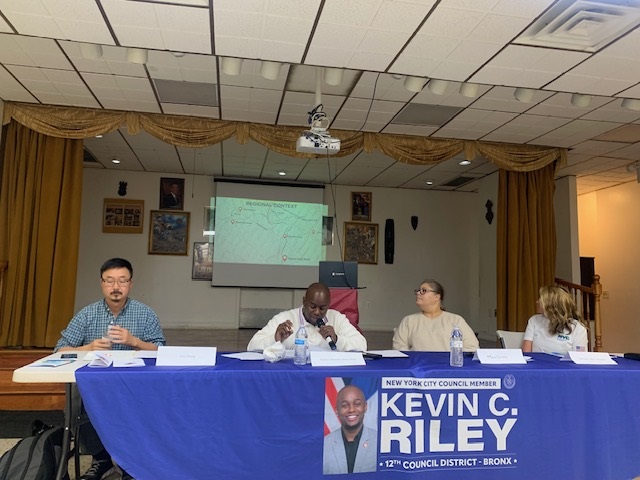
On October 25, 2023, the community of St. Lukes’ Episcopal Church convened to discuss Storm Resiliency. Spearheaded by Councilmember Kevin Riley, the interactive dialogue saw representatives from multiple government agencies forming a panel to address the attendees.
The principal panelist, Maria Cateno – Director of Office of Community Outreach and Communication NYC Dept of Design and Construction, took the lead to delineate the areas within district 12 grappling with persistent flood issues.
Eleftheria Ardizzone, Bronx Community Liaison for the NYC Department of Environmental Protection, urged resident homeowners to conduct routine cleaning of street basins pre-storm to mitigate localized flooding. In case of drainage failures, she advised residents to lodge their complaint via call to 311.
Jong Wong PE, the Director of Operations NYS dept of transportation for NYC region, unpacked the recent infrastructural enhancements made along local heavily frequented roadways such as the Bronx River parkway.
Councilmember Kevin Riley reviewed various legislative decisions pertaining to the district and reminded community members to voice any concerns to his staff.
During the Questions and answer period, Patricia McDow, representing the 3100 Homeowners Association, drew focus to identifying designated flood risk areas within the 12th district along with funding measures for undesignated zones. Although lacking immediate answers, Councilmember Riley promised that the answers would be provided by his team.
The highlighted changes to the Gunhill Road street pattern were queried by Ms. McDow. The Councilmember clarified that the changes were decided before he assumed office but assured that relevant concerns, including bus route efficiency, had been considered in the decision-making process following an on-site tour. An upcoming appointment for an absent community representative was also shared.
Additional queries emerged surrounding environmental protection from the extensive digging required for pipework. Ardizzone confirmed adherence to safety codes and affirmed no existing threat to community safety. She further proposed the usage of Home-Depot’s Flood Sensor for flood-prone households.
The meeting illustrated the solidarity within the community by distributing Flood Barriers courtesy of the Department of Environment Protection. Several advisories were shared which included signing up for NYC’s free emergency notification system, reporting post-storm property damage, and application processes for disaster assistance.
Engagement with DEP Infrastructure Grant program’s upcoming virtual session was encouraged, scheduled for December 8th at 2 pm.

Jehovah’s Witnesses Launch Invitation Campaign

Metro New York Residents Invited to Two Special Events in March
BRONX, N.Y. — March 2024 — While the date Sunday, March 24, may pass imperceptibly for many, millions around the world will gather at sundown to commemorate the death of Jesus Christ.
Considered the most important day of the year for Jehovah’s Witnesses, the Memorial is observed annually on Nisan 14 of the Jewish calendar in adherence to Jesus’ statement found at Luke 22:19, “Keep doing this in remembrance of me.” Though there are over 8.6 million Jehovah’s Witnesses around the world, over 20 million people attended the event last year.
“The Memorial is a global event that is attended by many who are not Jehovah’s Witnesses. We hope our neighbors in the local community will join us to gratefully remember what Jesus Christ accomplished by his sacrifice,” said Mark Godoy, spokesperson for Jehovah’s Witnesses.
The one-hour event will feature a talk highlighting the significance of Jesus’ death and what it means for all of mankind.
In metro New York, a special campaign will be launched during March 2024 to invite local residents to attend the annual observance of the Lord’s Evening Meal as well as a special public talk that will be delivered the week before.
Titled “The Resurrection—Victory Over Death!”, the special talk will be delivered at local Kingdom Halls on the weekend of March 16 and 17, 2024. This 30-minute, Bible-based public discourse will focus on the scriptural hope of a resurrection of the dead in the near future.
Harlem resident Betty Howard says: “I look forward to the special talk and Memorial every year. These events help keep me focused on what’s important now while also giving me the opportunity to appreciate what God will do for us in the future.”
To learn more about how Jehovah’s Witnesses observe the Lord’s Supper, please visit the event’s Frequently Asked Questions page found on jw.org, the official website of Jehovah’s Witnesses.
For more information about the 2024 Memorial and special talk and how to attend, please visit jw.org.

Bronx Week Parade and Huge Success on Grand Concourse
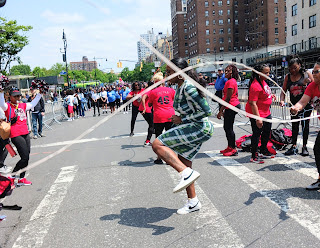
By Robert Press
Sunday’s Bronx Week Parade, Food Festival and Concert was moved back to its original site on the Grand Concourse where it was a success. Bronx Borough President Vanessa L. Gibson was joined by Co-Host Asha McKenzie of News 12 at the reviewing stand, and midway through the parade Bronx Borough President Gibson left the reviewing stand to become part of the Bronx Week Parade joining in with the people marching, holding up their signs, and taking cameo photos with them.
It was said that since the event was not being held on Mosholu Parkway that there would be no participation from the Northwest Bronx, but that proved not to be true as the Bronx Community Board 7 banner marched down the Grand Concourse from the beginning at East 167th Street to the end at East 158th Street. The Northwest was also represented by MS 80, Intech Academy, and PS 94. Elected officials who marched in the parade included Bronx District Attorney Darcel Clark, State Senator Robert Jackson, City Councilwoman Althea Stevens, and Assemblywoman Chantal Jackson.
The parade lasted for over ninety minutes as over fifty-five different schools, organizations, or neighborhood groups marched down the Grand Concourse to just past the Bronx County Building. As for the Food Festival and Concert there was a bit of drama as the original bandstand was to large to fit where it had to go in Joyce Kilmer Park, so a second smaller bandstand was brought in that fit perfectly into the area allocated for the bandstand. Hundreds of people enjoyed a larger viewing area in the park than the tight cramped viewing area that was on Mosholu Parkway. The Food Festival was set up on the service road to the Grand Concourse from East 164th Street to and looping around East 161st Street along the side of the park and there seemed to be even more vendors this year. Mr. Freddy Perez who was in charge of the Food Festival and Concert was happy with the way things went in setting up and said for next year it will be even easier to set up now that we know exactly what we need.
Street Co-Naming - Angellyh Marieh Yambo Way
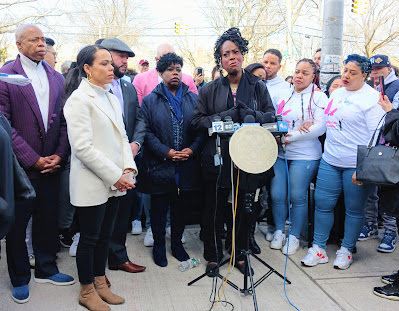
By Robert Press
It was one year prior that this sixteen year old was killed by senseless gun violence while on her way home from school at 1:45 PM. She was a couple of blocks from her high school University Prep when shots rang out killing her and injuring two other students from the school campus who were according to police caught in a gang crossfire.
In front of 3440 Bailey Avenue where Angellyh Marieh Yambo grew up was a new street sign to be unveiled with the signs Bailey Avenue and Bailey Pl. A street sign Angellyh Marieh Yambo Way to honor the young girl who wanted to be a doctor as requested by her parents and family at the place she grew up, and not the place she was murdered. That was done by City Council members Rafael Salamanca Jr. and Pierina Sanchez.
New York Mayor Eric Adams, Bronx Borough President Vanessa Gibson, Bronx District Attorney Darcel Clark, City Council member Salamanca and Sanchez, family members, friends, and others joined in to celebrate this street co-naming for Angellyh Marieh Yambo to remember a fine young girl who grew up in the neighborhood.
Each of the family members and elected officials spoke decrying this senseless killing. Councilman Salamanca hosted the event and explained the process of street co-namings. Mayor Adams said in his speech that he wants to get guns off the streets, because they are killing people and there is no place for them in our society. Bronx Borough President Vanessa Gibson said it is a day to celebrate a life that was cut short, a bright young student cut down in her prime, and that this cycle of violence must be broken. Bronx District Attorney Clark said that she will get justice for the family.
BRONX WEEK Walk of Fame Induction
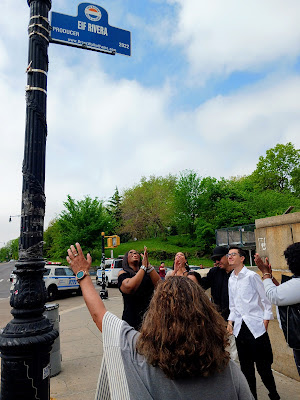
By Robert Press
In between Saturday’s showers the BRONX WEEK Walk of Fame inductees had their names placed on street signs that were unveiled in front of Bronx Borough Hall on the Grand Concourse. This event returned after a two year hiatus due to COVID-19, and precludes the BRONX WEEK Parade, Food Festival, and Concert across Mosholu Parkway which ends BRONX WEEK.
The 2022 inductees to the Bronx Walk of Fame were, Cinematographer-Producer Elf Rivera, actor Luis Antonio Ramos, and Artist, Actress, Writer Remy Ma who each unveiled their Bronx Walk of Fame Sign. Joining the three inductees was former inductee Fat Joe, who may have been auditioning for a job after Rap as a reporter for News 12 as he interviewed Bronx Borough President Vanessa Gibson and inductee Remy Ma.
SEC. FUDGE, SCHUMER, BOWMAN & HOCHUL ANNOUNCE FED CLOSING OF CO-OP CITY’S HUD LOAN REFINANCE; STATE AND LOCAL GOVERNMENT BACKING SUPPORTS RE-FI TO PROVIDE IMMEDIATE INJECTION OF OVER $100 MILLION DOLLARS TO MAKE REPAIRS & CRITICAL INVESTMENTS IN WORLD’S LARGEST HOUSING COOPERATIVE
The Bronx’s Co-op City To Receive $124 Million To Make Repairs & Upgrades For 45,000 Who Call It Home
Refinance Will Help Keep Co-op City In Tip-Top Shape For Residents In Increasingly Expensive Housing Market
United States Department of Housing and Urban Development Secretary Marcia L. Fudge, U.S. Senate Majority Leader Charles Schumer, Congressman Jamaal Bowman, and Governor Kathy Hochul announced today that Riverbay Corporation, the management company for Co-op City, HUD, Wells Fargo, the Mortgage Insurance Fund of the State of New York Mortgage Agency, and NYC Housing Development Corporation closed on the refinancing of Co-op City’s HUD loan, which will maintain long-term housing quality and affordability for the over 45,000 residents. Refinancing provides the housing company with $124 million in proceeds that will be used for capital improvements, including upgrades to the HVAC, façade maintenance, and electrical systems.
“We applaud the successful completion of the refinance for the Bronx’s Co-op City Complex,” said Secretary Marcia L. Fudge. “The Biden-Harris Administration and HUD are committed to stabilizing the housing market nationwide using every tool at our disposal, including utilizing Federal Housing Administration multifamily mortgage insurance as a key financing source. From supporting larger loans in major metropolitan areas to smaller loans in rural communities and suburbs, HUD is proud to be a partner in creating and preserving affordable housing across the country.”
“The Bronx’s Co-op City provides an affordable home to more than 45,000 New Yorkers in an increasingly expensive housing market,” said U.S. Senator Charles Schumer. “That’s why I worked to secure a timely refinance agreement for Co-op City, which will help maintain the quality, viability and long-term affordability of this one-of-a-kind community. The deal will also improve the lives of the residents by allowing repairs and other improvements to be made, all while providing affordable housing for generations to come. We haven’t stopped pushing and working with HUD to lock in the refinance and we are proud to announce its closure.”
“Co-op City is truly a one-of-a-kind community, home to the largest affordable housing cooperative in America and more than 45,000 constituents that I am honored to serve, ” said Congressman Jamaal Bowman Ed.D (NY-16).“It is imperative that the Co-op City community has the funds needed to maintain their affordable housing and commercial space, which supports all who live there. I am proud to have worked alongside the U.S. Department of Housing and Urban Development under Secretary Fudge’s leadership, Majority Leader Schumer, and Governor Hochul to advance a timely refinance agreement for Riverbay Corp, which will unlock significant capital funds for urgent repairs. Co-op City is a prime example of what cooperative housing can look like across this nation and I look forward to seeing how this loan refinance will continue to support making this community even more sustainable, livable and affordable.”
“My administration is committed to maintaining access to safe, quality affordable housing that enables New Yorkers to live with the dignity they deserve,” Governor Kathy Hochul said. “This transformative injection of capital funding will allow us to modernize Co-op City, the largest housing cooperative in the world, and ensure long-term affordability for its 45,000 residents.”
“One of HUD’s top priorities is the preservation of affordable housing, and this refinancing ensures Co-op City remains affordable for thousands of families,” said Alicka Ampry-Samuel, HUD Regional Administrator for New York and New Jersey. “It is also crucial that this development remain safe and residents continue to live in updated, quality units, made possible by HUD FHA’s influx of funds. Co-op City families will benefit from these improvements and will be able to enjoy their community for many years to come.”
“This loan will assist us to maintain our buildings and infrastructure while reducing the need for our residents to pay huge fee increases,” said Co-op City Board President Bernard Cylich. “On behalf of the Board of Directors and residents, I want to thank all of the government agencies and elected officials who have supported us and worked together to get this loan closed.
“Wells Fargo is pleased to have again structured the long term financing for Co-op City,” said Alan Wiener, Head of Multi Family Capital for Wells Fargo. “Our commitment to providing long term financing for affordable and moderate income housing is unparalleled in the industry. We would like to congratulate our elected partners Senator Schumer, Representative Bowman and Governor Hochul, as well as our agency partners at HUD, New York State, and New York City who worked with us to make this possible.”
“I am enormously proud of this partnership that will protect affordable homeownership at Co-op City for another 35 years,” said Homes and Community Renewal Commissioner RuthAnne Visnauskas. “In addition to keeping maintenance fees stable for residents, the $621.5 million loan will finance much-needed capital repair projects to ensure that all 15,372 homes remain safe and secure for the long term. Generations of New Yorkers have benefitted from the ability to live affordably in this bustling and diverse community while building
“The refinancing of Co-op City represents a critical investment in our existing affordable housing stock at a time of urgent need,” said HDC President Eric Enderlin. “Thanks to the collaboration of our partners and elected officials, this preservation effort will ensure lasting affordability and extensive capital repairs that will provide housing stability and improved quality of life to the thousands of New Yorkers that reside in this dynamic community.”
The 2012 Wells Fargo mortgage loan to Riverbay Corporation, which owns Co-op City, was the largest ever insured under the Department of Housing and Urban Development’s Sec. 223(f) program, which protects lenders against loss on mortgage defaults at multifamily properties.
The restructured $621.5 million mortgage loan from Wells Fargo extends the term of affordability for an additional ten years and provides $124 million for the cooperative to undertake necessary capital repairs. With 15,372 homes, Co-op City is the largest cooperative housing development in the world. The Mortgage Insurance Fund of the State of New York Mortgage Agency, which is part of New York State Homes and Community Renewal, and the New York City’s Housing Development Corporation, will provide credit support with $55 million and $15 million coverage of the loan, respectively. The loan includes $15 million for immediate capital repairs, including approximately $10 million for balcony and façade repair, $2.5 million for the replacement of residential water pumps and $2.5 million for the replacement of garage elevators. The loan also includes $109 million to replenish a reserve account for future repairs, all without raising maintenance charges for residents.
Co-op City is home to over 45,000 residents on 320 acres – the single largest co-op development in the country. The site has multiple schools, three commercial malls, and its own power plant. It has provided tens of thousands of families the opportunity to grow up in a stable middle-class community. This refinancing arrangement will help ensure tens of thousands more have that same opportunity and provide proceeds to make capital investments that will benefit residents for years to come.
The New York City Housing Development Corporation (HDC) is the nation’s largest municipal Housing Finance Agency and is charged with helping to finance the creation or preservation of affordable housing for New Yorkers. HDC also serves as a key financing partner in the rehabilitation of our city’s public housing stock under the NYCHA Permanent Affordability Commitment Together (PACT) initiative. Since 2003, HDC has financed more than 201,000 housing units using over $28 billion in bonds and other debt obligations and provided in excess of $3 billion in subsidy from corporate reserves and other available funds held by the corporation. HDC ranks among the nation’s top issuers of mortgage revenue bonds for affordable multi-family housing on Thomson Reuter’s annual list of multi-family bond issuers. In each of the last five consecutive years, HDC’s annual bond issuance has averaged $2 billion. For additional information, visit: http://www.nychdc.com
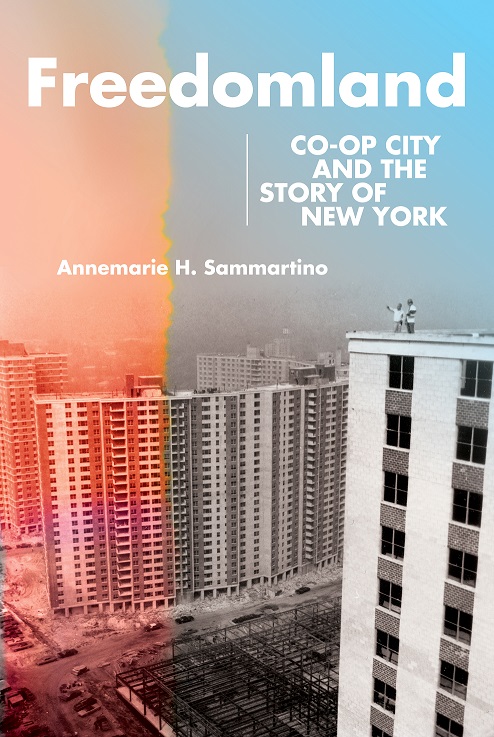
An interview with Annemarie Sammartino
- What is your book about?
Freedomland tells the story of Co-op City from its tumultuous planning process in the 1960s through the largest rent strike in American History in the 1970s and the community’s reinvention after white flight in the 1980s. The book ends in the early 1990s, just as Co-op City celebrated its 25th anniversary and achieved some hard-won financial stability (in carrying charge rates, at least).
As residents well know, Co-op has been reviled for everything from its brutalist style to its role in the destabilization of the Grand Concourse neighborhoods, to the intransigence and irascibility of its residents, and the idea that its construction defects made it an unaffordable boondoggle. As I argue, each of these charges is somewhat overblown (okay, the construction defects were pretty bad). But the book isn’t just about Co-op City alone, it’s also a story about New York as a whole from the 60s to the present; of race, ethnicity, class and urban crisis, and neoliberalism–but also of community, resistance, and utopia.
- How did you come to write about Co-op City?
Well, the short version is that I grew up here and my mom and sister still live here. But there’s a longer version to that tale. Growing up, I’ll be honest, I wasn’t a huge fan of Co-op–I mostly just wished it was more exciting. I never thought in a million years that I would ever write about it. After College, I became a historian, specializing in German history, which meant I lived in Berlin for a number of years while I was working on my dissertation and first book. While I lived there, German friends would often ask where I grew up in New York. And I found myself often comparing Co-op City with this huge East German housing development, Marzahn, on the outskirts of Berlin. After making the comparison a thousand times, I started wondering why a development in the Northeast Bronx looked like one in Northeast Berlin. This led me to research global post-WWII modernist urban planning, and also to want to know more about Co-op City specifically. What I found was that Co-op City was mostly absent from histories of New York, but there was a fascinating story to tell. And so…I decided to tell it!
- What do you think is unique about Co-op City?
At the risk of cliche, I would say it’s Co-op City’s size. Co-op City was the largest housing development built by the United Housing Foundation, a cooperative housing developer that was backed by labor organizations and was responsible for projects across New York. It had the largest mortgage ever granted through the Mitchell Lama program. It was also home to the largest rent strike in American history in 1975-76. And while many have reviled Co-op City’s size–saying it was impossible to create a community in such a large development, or that the size meant that Co-op City had problems that were too large to fix–in reality, I found that Co-op City’s size was just as often a benefit. It’s a complicated story (and one I tell in the book), but one of the major reasons that the rent strike succeeded in achieving resident control was that Co-op City was literally too big to fail. Furthermore, the fact that Co-op City had representatives in Albany who were indebted to their Co-op City voters meant that sometimes Co-op City was able to get attention and assistance that other affordable housing communities often could not.
Another thing that is unique about Co-op City is that it is an exclusively middle class community in a city that has become increasingly unaffordable. One thing this means is that Co-op is a great deal–as many residents (inc. my own parents) said to me, “it’s the best deal in New York!” But another thing that I argue is that because residents were all from roughly the same class background, the racial transition of the 1970s and 1980s, when Co-op City became a majority non-white community was more peaceful than this transition was in a lot of other parts of the city. Co-op City was never the paradise that a lot of people hoped it would be, but I think the ability to create and sustain a middle class community in New York is a pretty impressive accomplishment.
- What do you hope residents get out of the book?
I am hoping that Freedomland will be read by a lot of different people. I hope it will be read by activists, by historians, by urban planners, etc. But maybe mostly, I am hoping it will be read by residents and former residents who realize how important they and their progenitors have been in making Co-op City, and indeed New York as a whole, the place that it has become. I am writing in part for people who, like me, may have under-estimated the place and its residents to realize just what an important place it really has been.
- What was your favorite part of researching the book?
I think my favorite part of working on the book was getting to see familiar places in an unfamiliar light. For example, one random fact: I found out that construction defects meant that there was a room in Truman that could only be used as a greenhouse, and I totally got a kick out of that. I also read through countless back issues of the Co-op City Times and City News and it was always interesting to see names and faces that were familiar. In some cases, my friends’ parents had been important figures in local politics and I had no idea! But maybe the best part was talking to current and former residents and hearing their stories. I loved learning random things from people, like how they played games in the basement tunnels of their buildings or how many different social clubs there were in Co-op City’s early years. I also found out that a bunch of early rappers had performed in Co-op, which made me feel like I’d really missed out by being born a little too late.
- How do I get a copy of the book?
Copies have been ordered for the Baychester Public Library. And it is available from amazon and Barnes and Noble, etc. But you can also go to the Cornell University Press website and order it there–if you do that and use the code 09BCARD when you do so, you can get 30% off of the list price.
leo.
Annemarie Sammartino grew up in the Alder Place townhouses and is now Professor and Chair of the History Department at Oberlin College.

Flashback
BYLINE: By Mick Harper
1. Which female artist released “Everybody’s Somebody’s Fool”?
2. Name the first No. 1 single by England Dan & John Ford Coley.
3. Which two actors are mentioned in “Key Largo” by Bertie Higgins?
4. Which song is Chris de Burgh most known for?
5. Name the song that contains this lyric: “Does she love me, with all her heart, should I worry, when we’re apart?”
Answers
1. Connie Francis, in 1960. The ballad topped international charts in Canada, New Zealand and Norway, as well as in the U.S. Francis released a German language version called “Die Liebe ist ein seltsames Spiel,” but it was speeded up as a polka.
2. “I’d Really Love to See You Tonight,” in 1976. Unfortunately the duo didn’t stay together long, with Dan Seals going out on his own.
3. “Bogie and Bacall.” Humphrey Bogart and Lauren Bacall starred in the film “Key Largo” in 1948.
4. “Lady in Red,” in 1986. Popular around the globe, it won an ASCAP Pop Music Award in 1988 for the Most Performed Song.
5. “A Lover’s Question,” by Clyde McPhatter in 1958. McPhatter’s version, co-written by Brook Benton, spent a week at the top of the R&B chart.
COOP CITY!

Manhattan has Avenues A-D and Brooklyn has Avenues A-Z. Which letter streets are not in The Bronx?

Metro North Parkchester/Van Nest Station Info Meeting

By Robert Press
Tuesday October 3rd was the Parkchester/Van Nest new Metro North information session. It seemed to be deja vu to me as I could recall meetings like this in the past, as the four Eastside Metro North stations have been slated to be built for over twenty years.
It seemed every ten years there were similar information sessions where people have been asked what would you like to see at the new station, what upgrades do you think the community might need, and where do you think the new stations should go? When I asked one of the Metro North people didn’t we do this several times before. The answer I received was originally it was a Metro North project where Metro North gathered the information. Then the project was turned over to the MTA who started the process from the beginning, and the project was given back to the Metro North so we have to do the same thing again.
Councilwoman Amanda Farias and Bronx Borough President Vanessa L. Gibson both were at this information session, and both spoke about the advantages of the four new Metro North stations. I was able to ask Borough President Gibson about the proposal to put six thousand affordable housing units total at the Parkchester/Van Nest and Morris Park stations only, and the no parking at all. That Community Board 11 would be getting over five thousand new units of affordable housing with the over five hundred units already being built. I mentioned Mayor Adams City of Yes plan to build 100,0000 new units of affordable housing split across the fifty-nine community boards which would be less than two thousand per board. I also told the BP of the Harrison station up the line where Governor Hochul announced one hundred-forty-three new affordable units of housing, a shopping center with over seven hundred total parking spaces for the affordable housing, Metro North station, and shopping center. Borough President Gibson agreed that it would be too much housing for Community Board 11, and that parking would be needed.
The next Metro North information session is on Wednesday October 18th for the Coop-City station, and will be held from 6 – 8 PM at Section 5 135 Einstein Loop.
Today.. Brunch at The Dumpling Cove.. $34.99 ... Classy Family Setting...

"Roadmap to Progress: Upcoming MTA Developments Stir Excitement and Concerns in Coop City Community"
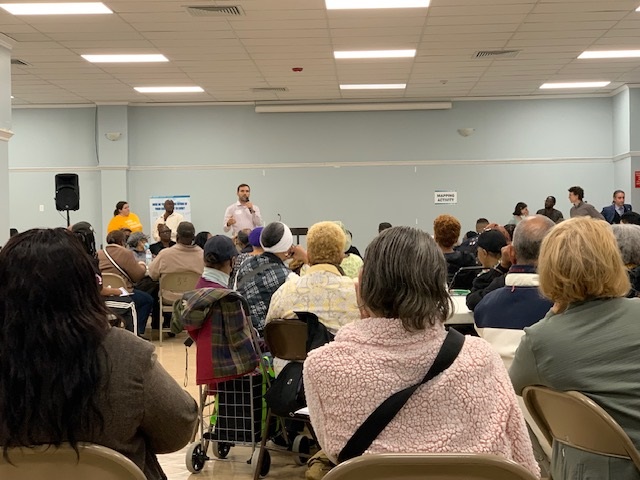
I wanted to share a quick update on an important community development project that’s underway. As you may be aware, Kevin Riley’s office, in collaboration with representatives from MTA, recently held an information session for the Coop City Community. This marked the second session focusing on this project. Here are the highlights:
The projected train stops are Morris Park, Parkchester, Coop City, and Hunt Point. Naturally, this development does stir up some concerns among our community members, particularly regarding parking and potential changes to traffic routes.
To address this concern, it was clarified that the highway segment will indeed be rerouted once the new ramp is in place. It’s certainly a significant change, but steps are being taken to ensure minimal disruption for our community members. However, the resident is voicing concerns as it relates to the ramp.
As of now, the target date for completing the entire project is set for 2027.
Our team understands that communication is key when it comes to projects that directly impact the community. Therefore, another information session has been scheduled at the Community Board 10 on November 8th. We encourage all Coop City residents to attend and voice their thoughts and concerns as we navigate this project together.
By standing united, the community can ensure the successful implementation and overcoming any challenges thrown their way.
THE CLASSIC BLACK MOVIE BRUNCH AND DAY PARTY SERIES Presents

A Pre Mothers Day and Taurus Celebration Saturday May 4, 2024 COME OUT AND MEET AND GREET MOVIE STAR LEON & THE Legendary RnB Group SURFACE FOR TICKETS & TABLES CALL 516-362-9839 or GO ONLINE TO WWW.EVENTBRITE.COM

How to Create and Promote Your Digital Business Card: A Step-by-Step Guide
How to Create and Promote Your Digital Business Card: A Step-by-Step Guide is a practical resource that takes you through the process of designing, creating, and promoting your digital business card effectively. It includes expert tips, case studies, and insights to help individuals and businesses establish a strong digital presence and stand out in today’s competitive landscape.
https://www.amazon.com/dp/B0BXNFRTYT?ref_=pe_3052080_397514860


New SBS opportunity loan program

Mayor Adams and Small Business Services Commissioner Kevin Kim Announce Seventy-Five Million Dollars in Low Cost Small Business Loans
Mayor Adams came to Nohble on Jerome Avenue just below Kingsbridge Road to announce with SBS Commissioner Kim to announce the largest public-private loan fund directed at small businesses in New York City history. Fifty million dollars will be put in by Goldman Sachs and Mastercard to be matched by twenty-five million dollars put up by New York City.
Approximately 1,500 local business geared towards minority and women owned businesses will be eligible for loans up to $250,000.00 with interest rates set at 4%. Credit score minimums will be eliminated, and no application fees will be charged to ensure broad access to the loan fund. Mayor Adams said “Our efforts to cut red tape and jumpstart our recovery are already delivering results. 13,600 new businesses opened in the first half of 2022, including 1,800 new storefronts. Small businesses kept us going through the pandemic, and we are giving back to them with the Small Business Opportunity Fund.
SBS Commissioner Kim said this loan fund will unlock opportunities for businesses hit hardest by the pandemic by offering flexible and affordable financing to help businesses recover and grow. New York City’s small businesses need a boost, and with the launch of the historic NYC Small Business Opportunity Fund, SBS is delivering.



New York State Utility Assistance Announced
The New York State Public Service Commission approved a $672 million utility electric and gas utility bill relief late
Thursday that will give economic assistance to 478,000 non-low-income New Yorkers and 56,000 small businesses.
The program, designed by the Energy Affordability Policy Working Group, aims at covering New Yorkers' bill arrears
accumulated through May 1, 2022, due to the Covid-19 pandemic, which caused significant financial hardship for
customers, the shuttering of businesses statewide, and the loss of jobs. The relief plan would eliminate 75 percent of
recipients' past due bills thanks to a one-time credit, partially resolving the remaining 25 percent's arrears.
Gov. Kathy Hochul announced the PSC decision on Friday morning. "Every New Yorker deserves affordable energy, yet
too many New Yorkers are at risk of having their lights turned off due to financial problems caused by the pandemic,"
Hochul said.
The electric and gas utility assistance plan is the second action conceived as part of helping New Yorkers pay off past-
due utility bills. The first one — a $567 million relief program — was announced by Hochul last summer and
addressed low-income customers.
Congresswoman Alexandria Ocasio-Cortez Coop-City Town Hall Meeting
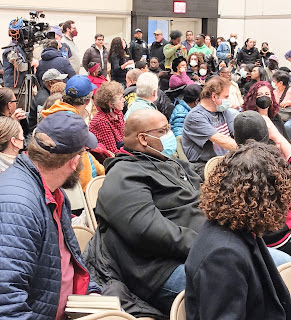
By Robert Press
Saturday Afternoon Congresswoman Alexandria Ocasio-Cortez held her first Town Hall meeting in auditorium C of 177 Dreiser Loop in Coop-City near where her new Coop-City office is located in Room 3 of 177 Dreiser Loop. Hundreds of people were in attendance to see and hear their new congresswoman that redistricting had given them. Many in the audience were familiar with their new representative in congress, and most of them approved of the job she is doing.
Congresswoman Ocasio-Cortez’s Town Hall meeting opened with a short welcoming by Assemblyman Michael Benedetto, and then the Congresswoman spoke about the SUV Crime Intervention unit at Jacobi Hospital where she was able to obtain $1.2 million dollars, She continued saying that one million dollars was obtained for the overhaul of the Westchester Square area to make it safer for pedestrians, and while she was talking several people stood up in protest of the United States support of the war in the Ukraine. The protesters were escorted out of the auditorium.
As Congresswoman Ocasio-Cortez continued she spoke abut the Debt Ceiling, fighting cuts to programs such as Social Security and Medicare, new energy credits, and the removal of former President Trump’s tax credits for the rich. When she got into the Question and Answer part of the Town Hall, she was interrupted on the first question when a voice shouted out why she voted against the Infrastructure Bill in Congress, where she explained there was the promise of including much needed support for public housing such as NYCHA that was cut out from the bill.
To a question on the budget, the congresswoman answered that her opposition to the defense budget is because there i no accounting of how the money allocated is spent. As for the problems at Rikers Island she is in favor of federal receivership of the jail which she stressed is only a jail and not a prison. She mentioned a queens hospital where a new maternal health center was created with her getting federal funding with additional city funding to open the maternal health center, and when this reporter was able to ask the congresswoman if she would do the same thing at the empty building #2 at Jacobi Hospital in her district, her answer was a resounding yes because she knows of the problem that women in the Bronx have during pregnancy. After the Town Hall ended Congresswoman Ocasio-Cortez met those who wanted to speak to her one on one
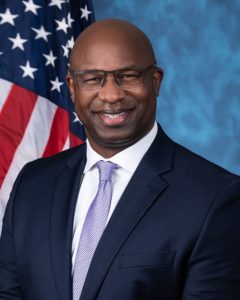
Rep. Jamaal Bowman Delivers $500,000 in Funding to Co-op City to Improve Greenspace & Waterfront Resilience
Co-Op City, NY – Today, Congressman Jamaal Bowman, Ed.D. (NY-16) joined neighbors and local leaders in Co-op City to celebrate $500,000 in federal funding to revitalize currently polluted waterfront land in Co-op City into a community park to support the health and wellbeing of residents.
“Everyone should have easy access to outdoor spaces to gather, exercise, relax and enjoy nature,” said Congressman Jamaal Bowman, Ed.D. (NY-16). “For too long, the government has failed to provide high-quality green space for residents in low and moderate-income communities compared to those in wealthier areas. This is environmental injustice and can lead to higher rates of chronic health issues like obesity. Co-op City houses over 45,000 neighbors in New York’s 16th Congressional District and included in this development is waterfront land that overlooks the Hutchinson River. Currently that land needs major improvements to turn it into a peaceful and environmentally resilient area for people to enjoy. However, Riverbay Fund, the Co-op City management entity, has a transformative plan to restore the waterfront land and turn it into a park which would in turn bring environmental justice to residents throughout Co-op. Co-op City residents deserve to have a beautiful waterfront that is clean and accessible, and I have heard from many in the community about the importance of this project. I am proud to have secured $500,000 through the fiscal year 2022 appropriations process which would make that a reality soon. I look forward to joining neighbors once renovations and restorations are complete to celebrate Co-op City leading the district into climate resilience and a greener future.”
“I am proud that the Riverbay Fund and its community partners were able to secure a grant from Congressman Jamaal Bowman on behalf of Co-op City securing the start of building an open space with a park and recreational activities that lend support to a better quality of life and health initiatives for our community,” said Sonia Feliciano, 1st Vice President of the Riverbay Board.
Rep. Jamaal Bowman Introduces the Affordable Co-op Act to Increase Federal Support for Cooperative Housing Models
Co-op City, NY – Today, Congressman Jamaal Bowman, Ed.D. (NY-16) hosted residents in Co-op City, housing advocates, local elected officials and community leaders to announce his Affordable CO-OP (Collective Opportunities for Owning Property) Act.
“My American dream is to live in a country where everyone has access to dignified housing,” said Congressman Jamaal Bowman, Ed.D (NY-16). “As housing prices and the cost of living reach an all time high and wealth inequality grows, more and more people are being shut out of the opportunity to stay stably housed or become homeowners due to high prices, wealth disparities, and corporate greed in the real estate sector. From redlining and exclusionary zoning to credit and lending discrimination, our nation continues to face an urgent, racially unjust housing crisis that disproportionately harms Black, brown, low-income, and elderly people.
“My bill, the Affordable CO-OP (Collective Opportunities for Owning Property) Act, would expand federal support for affordable housing cooperatives to make homeownership more accessible for people who have been historically exploited by a real estate industry prioritizing profits over people. Limited equity cooperative housing is a type of affordable housing that allows residents to communally own their own property, have a stake in decision-making, and sell units at a price that maintains affordability for future residents. This bill would unlock more federal funds to develop and convert properties into limited equity cooperatives, and ensure that cooperative residents have access to funds for resilience improvements, community programming, and other support they need to thrive.”
“In my district, Co-op City is a prime example of how shared equity housing can foster community and long-term affordability for all. Co-op City is the largest housing cooperative in the world and the largest Naturally Occurring Retirement Community in the nation, with over 45,000 residents. Here, neighbors enjoy their own homes with affordable mortgage payments, can age in place and build lasting relationships with their neighbors over generations. If we center people in our housing policy, housing justice can finally become a reality for all.”
Specifically, the Affordable Co-op Act will:
- Equip HUD to issue zero-interest loans for the predevelopment, development, preservation, and conversion of properties into limited equity cooperatives for low-to-moderate income households.
- Create a new grant program for limited equity cooperatives for green retrofits, community development, democratic governance activities, and resident support programming.
- Revise FEMA and Weatherization Assistance Program policies to ensure cooperatives can access disaster relief funding and weatherization funds.
- Establish an Office of Shared Equity Housing at HUD to support affordable cooperatives and provide technical assistance to tenants, non-profits, and cities looking to support cooperative housing models
“Given our current housing crisis, it’s crucial we support access to affordable housing opportunities now more than ever,” said Senator Chuck Schumer (D-NY). “Co-ops have always been essential to expanding access to affordable housing for working families in New York. I was proud to work with Representative Bowman to secure a long-term $621 million loan for Co-op City to make critical capital repairs. We need to do all we can to continue to expand federal support for affordable housing cooperatives in New York, as proposed by the Affordable CO-OP (Collective Opportunities for Owning Property) Act of 2022, to support not only Co-op City and its residents, but all co-op housing across the state and country.”
“I am proud to support the Affordable CO-OP (Collective Opportunities for Owning Property) Act of 2022 presented by our Congressman Jamaal Bowman,” said Sonia Feliciano, 1st Vice President of the Riverbay Board. “It recognizes Co-op City as a national model and treasures preserving affordability for years to come.”
“Limited Equity Cooperative housing like Co-op City and the 1,200+ HDFC Co-ops in NYC have been extraordinarily successful in providing permanently affordable homeownership opportunities for New Yorkers for nearly 100 years, said Andrew Reicher, Executive Director of UHAB. “The Affordable CO-OP Act will not only expand this much needed housing opportunity in NYC but make this successful model available nation-wide.”
“The National Association of Housing Cooperatives (NAHC) represents thousands of housing cooperative units nationwide and has done so for the past sixty-one years. We strongly support the Affordable CO-OP Act, which focuses on government funding for the development and preservation of limited equity cooperatives in the U.S.,” said Fred Gibbs, President of the National Association of Housing Cooperatives. “This legislation aligns with our mission, “To support and educate existing and new cooperative housing communities as the best and most economical form of home ownership.”
For a one-pager of the bill please click here
For a section-by-section summary of the bill please click here
For full text of the bill please click here
Original co-sponsors of the legislation include Rep. Yvette D. Clarke (NY), Rep. Mondaire Jones (NY), Rep. Alexandria Ocasio-Cortez (NY), Rep. Rashida Tlaib (MI), and Rep. Bonnie Watson Coleman (NJ).
Sponsoring organizations and people include the Urban Homesteading Assistance Board (UHAB), National Association of Housing Cooperatives, National Cooperative Business Association, Leading Age, Center for Popular Democracy Action, US Federation of Worker Cooperatives, North American Students of Cooperation, Preservation of Affordable Housing (POAH), Coalition to Save Affordable Housing, Affordable Housing is for All, the New Economy Project, Housing Justice for All, and the New York Housing Conference.

- Bronx Co–Op City Dreiser Community Center
- Northeast Bronx YMCA (Edenwald)
- South Bronx Educational Campus
- West Bronx Gymnasium
- Lehman College – Apex Center
- Bathgate Contract Postal Station

